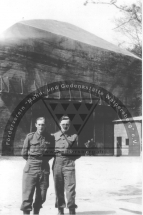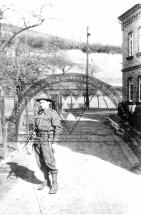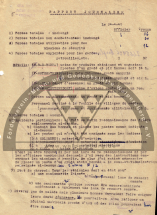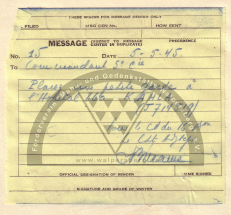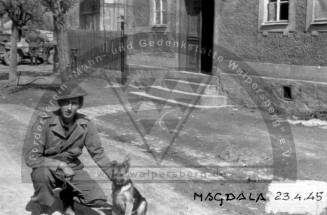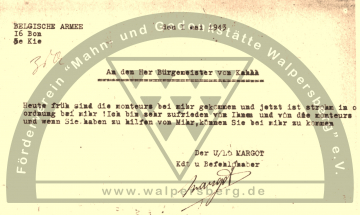On 1 April 1945, after the combats units had moved further east across the Saale, an M.G. (Military Government) was established in Kahla. The task of this organization was to bring daily life back to normality, a new beginning regulated by extensive regulations, since the war was still not over. Kahla was now becoming an important hub for replenishment and fuel storage. Of particular urgency was the clarification of the precarious situation of the thousands of former forced laborers. Most of them returned to their camps from the disbanded evacuation march that went from Kahla to Bavaria in the last days of the war. Each nation of forced laborers had his representative in Kahla with the M.G. Especially the escalating looting and poor health and nutrition status of people was a major problem.
A Belgian battalion arrived in Kahla on April 23, 1945. It is the 16th Fusilier Battalion, one of more than 60 battalions established by the Belgian government and placed under the Command of the Allied High Command as of from January 1945. This was only a light infantry, mobile and therefore intended for guard duties. Most of the 60 units remained in Belgium and were entrusted with tasks. Only a few of them went with the Allies.
The 16th Fusilier Battalion was established on 18 January 1945 in Bonsecours, Belgium. It included 800 soldiers, mainly from the Namur, Charleroi, Ardennes and Brussels regions, who were formerly members of the resistance. Therefore, the unit is also known as “NACHAR”, which stands as an abbreviation for Namur/Charleroi. Major Bolle lead the unit, which will be sent to Germany on March 12 after a seven-week training session, where it will support various American units. Just one day later, on 31 March, the 16th Fusilier Battalion crosses with U.S. units the Rhine near Linz. It will subsequently be taken over by the 8th U.S. Tank Destroyer Group. Their tasks include cleaning up possible enemy forces in the region’s vast forests, as well as finding and recovering ammunition left behind.
The battalion is already in the Hallenberg-Berleburg region on 11 April, where it is given further security tasks.
From 20 April, the battalion moves through Hessian Korbach to Thuringia and sets up its command post in Magdala, which will later be moved to Blankenhain. Their mission: to provide the security of the Allied troops and to secure their supplies. The unit remains stationed here until the end of the war, with its individual companies operating very dispersed. These include the regions of Werningsleben via Crawinkel, Ilmenau, Rudolstadt, Saalfeld and Kahla/Rothenstein, where the “REIMAHG” and “Albit” facilities were guarded. According to German eyewitnesses, the Belgians acted very harsh towards the population, which certainly resulted from the soldier’s origin, the resistance.
At the end of June, the battalion, which was already stationed in Kaltennordheim at the time, finally leaves Thuringia, which is taken over by the Red Army. Arrived in the Bavarian Franken region at the beginning of July, it was dissolved five months later, on 31 December 1945 in the army camp Beverlo, near Leopoldsburg, Belgium. During its operation, the battalion suffered four deaths and 19 serious injuries.
While conducting our research on this unit, we also participated several times in the annual veterans’ meetings, creating a close friendship with them and their families that continues to this day. On our invitation, they returned to Kahla in 2002 for the first time in 60 years and then came annually to the commemoration ceremony, to which they always brought their battalion flag.
The unit’s flag is now in the possession of our association.
